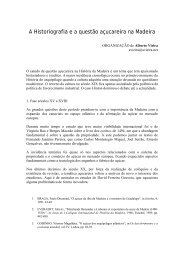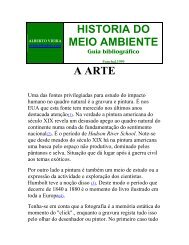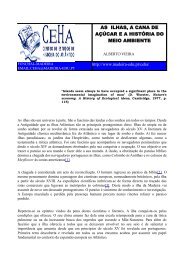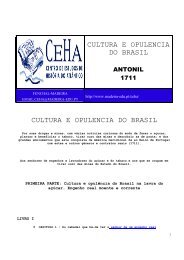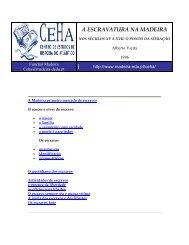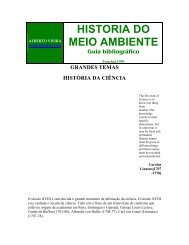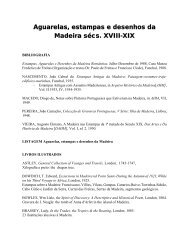SLAVERY IN MADEIRA
SLAVERY IN MADEIRA
SLAVERY IN MADEIRA
You also want an ePaper? Increase the reach of your titles
YUMPU automatically turns print PDFs into web optimized ePapers that Google loves.
diverse places; reveal that the economic intervention of the slave was much more<br />
complex. All give count of the slave mobility in the most varied activities.<br />
It is current opinion that the perfect symbiosis between slavery and agriculture, with<br />
special relevance for the sugar-cane culture, only started showing up in the XV century<br />
with the Madeiran experience, as, up until then, the use of the slave in such jobs, was not<br />
enough to justify the system. In fact, in the understanding of W. D. Phillips Jr., the<br />
connection slave/sugar only takes place in the Atlantic with the Madeiran case, being the<br />
situations in the Christian and Islamic Worlds sporadic.<br />
Here, it is necessary a reference to the particular situation in Madeira, that needs some<br />
adjustments. First, the presence of the slave during the sugar harvest-time is not as<br />
dominant as it might seem at first. It is certain that the slave is linked to the process, but<br />
didn't act isolated or was even majority in it. By his side was a large number of free men<br />
that worked on wages or were leaseholders. The conditions defined by the island are<br />
orographical and the property system was the cause of this peculiar reality.<br />
The slave, in many societies, apart from the economic function, also affirmed itself by the<br />
sumptuary value, being, in some of them, a way of social distinction. In Madeira, just like<br />
in some European areas, this is evident, as it can be observed in the works of Gaspar<br />
Frutuoso. In relation to Machico, he says: "there were many colored females and very<br />
well treated and of rich voices, which is a sign of the old nobility of its residents, as in all<br />
the big and rich houses there is this multiplication of the servers". However, in the<br />
Lombada of Arco da Calheta, lived Dona Isabel de Abreu, the widower of Joao<br />
Rodrigues de Noronha, son of Funchal's captain, with two farms "very thick", having at<br />
her service a female moor as "her private".<br />
From the sugar cane crisis, the excess of slave labor available might have caused a<br />
change in the activity sector and an exemption increase. The slave moves from the<br />
country to the city, increasing therefore the number of house servants in the big<br />
mansions, and workers in the offices. But, it is necessary to take into account, that, side<br />
by side with the slaves, in these houses, there were free workers referenced as waiters.<br />
The domestic service, was usually given to the females, seeing that the males would<br />
occupy themselves with the agricultural works, as artisans, or, otherwise, as hirelings.<br />
The female, still performed other jobs. Many became fruit sellers or washers.<br />
The selling of the lord's farming products in the local market by the slaves, burdened by<br />
many regulations, limitative of the fraudulent exercise. They were keen on stealing from<br />
the owner or the buyer, saving, sometimes, enough to get the exemption.<br />
The male slaves worked in many jobs of the socio-economic structure. They could be<br />
artisans, farmers, mule-drivers or hirelings. It is constant their presence in the income and<br />
expense books, as the one of Funchal's Customs. The lords also used them as substitutes<br />
in the building of fortifications, a job done by every citizen that would offer one day's<br />
working day for it.




